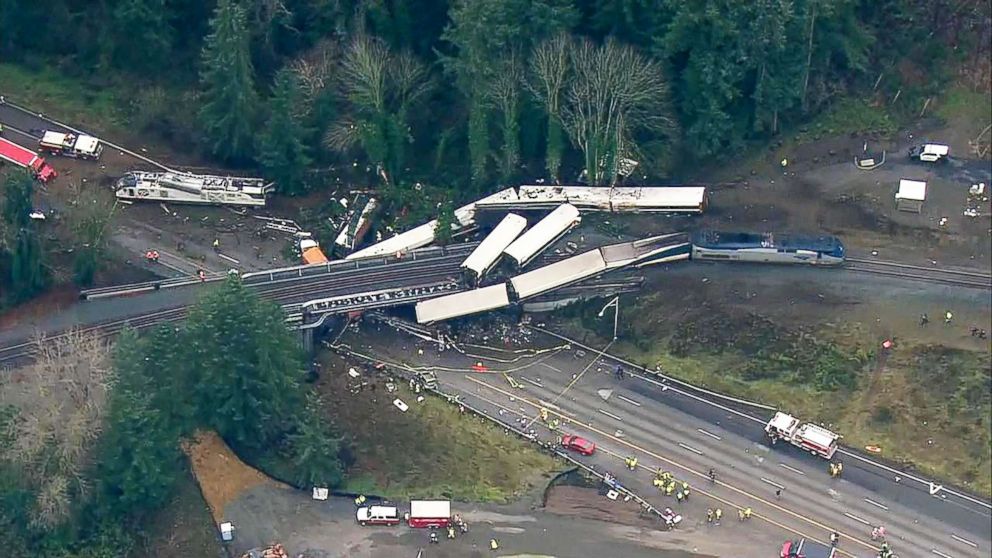13 car train, and 12 derailed. Several landed in I5 highway, hitting multiple vehicles.

I previously worked on designing cameras and recorders for use mainly in buses and trains. I thought folks here would like insight into camera systems used in trains.
NVR:
Most NVR models we discuss on this forum have 4 or 8 “external alarm” inputs. For buses and trains, there’s usually 12 to 20 inputs. This records the many inputs, such as:
- Brakes activated
- L & R turn signals
- Headlights on
- Door(s) open or closed
- “G” force above a threshold (excessive braking)
- G force (accident)
- Emergency flashers
- etc
The NVR also has an input for a GPS, to relate video footage to location and time. Useful for checking if a route is on-time. (NVR video time stamp vs gps location)
Cameras:
Here's a pic of a RR camera that is "forward facing", mounted in the locomotive cab. The dual camera is useful:
One lens: "looks long", to see RR crossings in the distance. To confirm the crossing lights were flashing (when cars crossed the tracks, or drove around the lowered gate arm.)
The other lens: "looks wide", to see what's close to the train, including views trackside L & R.

Quick aside: Some RR unions prohibit cameras in the cab of the locomotive that can record the train's engineer. The union didn't want mgmt micromanaging them....
Other RR companies allow recording of the engineer's actions while driving the train. It protects the engineer against charges of inattention, distraction, texting, even napping.
Two RR approaches to in-cab cams.
Bus companies are similar. Some cities can record the driver, in other cities, there’s no recording of the driver.
Amtrak: The "Black Box" required on trains have interesting specs, and are different than black boxes on airplanes.
Fastb

I previously worked on designing cameras and recorders for use mainly in buses and trains. I thought folks here would like insight into camera systems used in trains.
NVR:
Most NVR models we discuss on this forum have 4 or 8 “external alarm” inputs. For buses and trains, there’s usually 12 to 20 inputs. This records the many inputs, such as:
- Brakes activated
- L & R turn signals
- Headlights on
- Door(s) open or closed
- “G” force above a threshold (excessive braking)
- G force (accident)
- Emergency flashers
- etc
The NVR also has an input for a GPS, to relate video footage to location and time. Useful for checking if a route is on-time. (NVR video time stamp vs gps location)
Cameras:
Here's a pic of a RR camera that is "forward facing", mounted in the locomotive cab. The dual camera is useful:
One lens: "looks long", to see RR crossings in the distance. To confirm the crossing lights were flashing (when cars crossed the tracks, or drove around the lowered gate arm.)
The other lens: "looks wide", to see what's close to the train, including views trackside L & R.

Quick aside: Some RR unions prohibit cameras in the cab of the locomotive that can record the train's engineer. The union didn't want mgmt micromanaging them....
Other RR companies allow recording of the engineer's actions while driving the train. It protects the engineer against charges of inattention, distraction, texting, even napping.
Two RR approaches to in-cab cams.
Bus companies are similar. Some cities can record the driver, in other cities, there’s no recording of the driver.
Amtrak: The "Black Box" required on trains have interesting specs, and are different than black boxes on airplanes.
- Fire resistance of 750 °C for 1 hour, this test simulates the temperature of burning diesel fuel
- Impact shock of 55 g
- Static crush of 110 kN for 5 minutes, this test simulates a locomotive derailment and blunt object impact
- Fluid immersion in Diesel, water, salt water or lube oils for 2 days
- Hydrostatic pressure equivalent to immersion to a depth of 15 m in water for 2 days
Fastb

